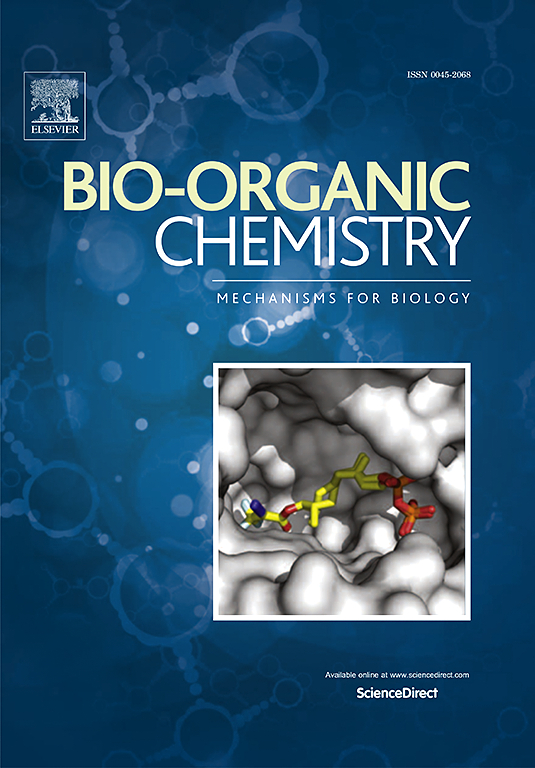设计包含功能化苯并噻唑配体的新型三齿铱(III)配合物,通过靶向线粒体提高抗癌活性
IF 4.5
2区 医学
Q1 BIOCHEMISTRY & MOLECULAR BIOLOGY
引用次数: 0
摘要
近年来,有机铱抗癌药物对癌细胞显示出良好的抗肿瘤活性。本文设计合成了以苯并噻唑为基础的2,2′-(5-(叔丁基)-1,3-苯基)-双(苯并[d]噻唑)(L1)和2,2′-(5-(甲基)-1,3-苯基)-双(苯并[d]噻唑)(L2)两种三齿配体,并与2,2′-联吡啶(bipy)和1,10-菲罗啉(phen)辅助配体结合,形成了一系列新型的[Ir(N^C^N)(N^N)Cl]+型铱(III)配合物(Ir1-Ir4)。这些配合物的磷光特性有助于它们的亚细胞定位和与其他生物分子的相互作用的可视化。其中复合物Ir2对A549细胞的细胞毒活性最好,并进一步评价其抗肿瘤活性。激光共聚焦分析显示,Ir2遵循能量依赖的细胞摄取机制,并特异性地在线粒体中积累(Pearson共定位系数:0.89)。通过细胞凋亡、细胞周期阻滞、western blotting (WB)、活性氧(ROS)水平和线粒体膜电位(MMP)的变化来探讨其抗癌机制。体内抗肿瘤活性证实,Ir2能有效抑制肿瘤生长,抑制率为71.60%,优于顺铂。据我们所知,Ir2是[Ir(N^C^N)(N^N)Cl]+型复合物作为潜在抗癌剂的罕见例子。本文章由计算机程序翻译,如有差异,请以英文原文为准。

Designing novel tridentate iridium(III) complexes comprising functionalized benzothiazole ligands to improve anticancer activity by targeting mitochondria
In recent years, organo‑iridium anticancer agents have shown promising antitumor activity toward cancer cells. In this paper, two benzothiazole-based tridentate ligands, 2,2′-(5-(tert-butyl)-1,3-phenylene)bis(benzo[d]thiazole) (L1) and 2,2′-(5-(methyl)-1,3-phenylene)bis(benzo[d]thiazole) (L2), have been designed and synthesized, and then combined with 2,2′-bipyridine (bipy) and 1,10-phenanthroline (phen) ancillary ligands to form a series of novel [Ir(N^C^N)(N^N)Cl]+-type iridium(III) complexes (Ir1-Ir4). The phosphorescence properties of these complexes facilitate the visualization of their subcellular localization and interactions with other biomolecules. Among them, complex Ir2 has the best cytotoxicity activity toward A549 cells and its antitumor activity was further evaluated. Laser confocal assay reveals that Ir2 followed an energy-dependent cellular uptake mechanism and specifically accumulates in mitochondria (Pearson colocalization coefficient: 0.89). The anticancer mechanism has been explored through apoptosis, cell cycle arrest, western blotting (WB), reactive oxygen species (ROS) levels and mitochondrial membrane potential (MMP) changes. The antitumor activity in vivo confirms that Ir2 could effectively inhibit tumor growth with an inhibitory rate of 71.60 %, which is superior to cisplatin. To the best of our knowledge, Ir2 is a rare example of [Ir(N^C^N)(N^N)Cl]+-type complexes as potential anticancer agents.
求助全文
通过发布文献求助,成功后即可免费获取论文全文。
去求助
来源期刊

Bioorganic Chemistry
生物-生化与分子生物学
CiteScore
9.70
自引率
3.90%
发文量
679
审稿时长
31 days
期刊介绍:
Bioorganic Chemistry publishes research that addresses biological questions at the molecular level, using organic chemistry and principles of physical organic chemistry. The scope of the journal covers a range of topics at the organic chemistry-biology interface, including: enzyme catalysis, biotransformation and enzyme inhibition; nucleic acids chemistry; medicinal chemistry; natural product chemistry, natural product synthesis and natural product biosynthesis; antimicrobial agents; lipid and peptide chemistry; biophysical chemistry; biological probes; bio-orthogonal chemistry and biomimetic chemistry.
For manuscripts dealing with synthetic bioactive compounds, the Journal requires that the molecular target of the compounds described must be known, and must be demonstrated experimentally in the manuscript. For studies involving natural products, if the molecular target is unknown, some data beyond simple cell-based toxicity studies to provide insight into the mechanism of action is required. Studies supported by molecular docking are welcome, but must be supported by experimental data. The Journal does not consider manuscripts that are purely theoretical or computational in nature.
The Journal publishes regular articles, short communications and reviews. Reviews are normally invited by Editors or Editorial Board members. Authors of unsolicited reviews should first contact an Editor or Editorial Board member to determine whether the proposed article is within the scope of the Journal.
 求助内容:
求助内容: 应助结果提醒方式:
应助结果提醒方式:


